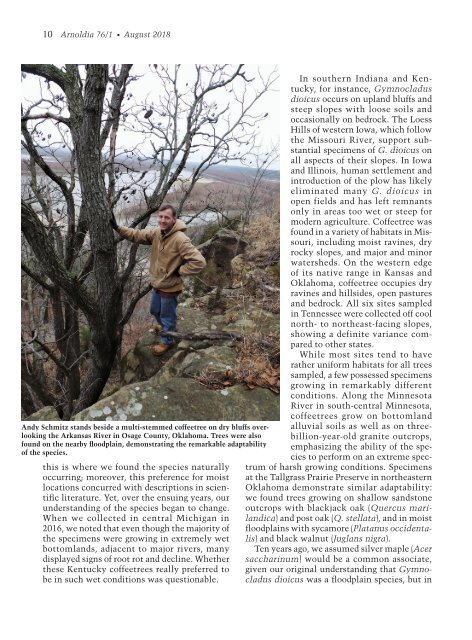Arnoldia Article full with cover Sept 2018
Exploring the Native Range of Kentucky Coffeetree by Andy Schmitz and Jeffrey Carstens, originally published in Volume 76, Number 1 of Arnoldia, produced by The Arnold Arboretum and published by Harvard University.
Exploring the Native Range of Kentucky Coffeetree by Andy Schmitz and Jeffrey Carstens, originally published in Volume 76, Number 1 of Arnoldia, produced by The Arnold Arboretum and published by Harvard University.
You also want an ePaper? Increase the reach of your titles
YUMPU automatically turns print PDFs into web optimized ePapers that Google loves.
10 <strong>Arnoldia</strong> 76/1 • August <strong>2018</strong><br />
Andy Schmitz stands beside a multi-stemmed coffeetree on dry bluffs overlooking<br />
the Arkansas River in Osage County, Oklahoma. Trees were also<br />
found on the nearby floodplain, demonstrating the remarkable adaptability<br />
of the species.<br />
this is where we found the species naturally<br />
occurring; moreover, this preference for moist<br />
locations concurred <strong>with</strong> descriptions in scientific<br />
literature. Yet, over the ensuing years, our<br />
understanding of the species began to change.<br />
When we collected in central Michigan in<br />
2016, we noted that even though the majority of<br />
the specimens were growing in extremely wet<br />
bottomlands, adjacent to major rivers, many<br />
displayed signs of root rot and decline. Whether<br />
these Kentucky coffeetrees really preferred to<br />
be in such wet conditions was questionable.<br />
In southern Indiana and Kentucky,<br />
for instance, Gymnocladus<br />
dioicus occurs on upland bluffs and<br />
steep slopes <strong>with</strong> loose soils and<br />
occasionally on bedrock. The Loess<br />
Hills of western Iowa, which follow<br />
the Missouri River, support substantial<br />
specimens of G. dioicus on<br />
all aspects of their slopes. In Iowa<br />
and Illinois, human settlement and<br />
introduction of the plow has likely<br />
eliminated many G. dioicus in<br />
open fields and has left remnants<br />
only in areas too wet or steep for<br />
modern agriculture. Coffeetree was<br />
found in a variety of habitats in Missouri,<br />
including moist ravines, dry<br />
rocky slopes, and major and minor<br />
watersheds. On the western edge<br />
of its native range in Kansas and<br />
Oklahoma, coffeetree occupies dry<br />
ravines and hillsides, open pastures<br />
and bedrock. All six sites sampled<br />
in Tennessee were collected off cool<br />
north- to northeast-facing slopes,<br />
showing a definite variance compared<br />
to other states.<br />
While most sites tend to have<br />
rather uniform habitats for all trees<br />
sampled, a few possessed specimens<br />
growing in remarkably different<br />
conditions. Along the Minnesota<br />
River in south-central Minnesota,<br />
coffeetrees grow on bottomland<br />
alluvial soils as well as on threebillion-year-old<br />
granite outcrops,<br />
emphasizing the ability of the species<br />
to perform on an extreme spectrum<br />
of harsh growing conditions. Specimens<br />
at the Tallgrass Prairie Preserve in northeastern<br />
Oklahoma demonstrate similar adaptability:<br />
we found trees growing on shallow sandstone<br />
outcrops <strong>with</strong> blackjack oak (Quercus marilandica)<br />
and post oak (Q. stellata), and in moist<br />
floodplains <strong>with</strong> sycamore (Platanus occidentalis)<br />
and black walnut (Juglans nigra).<br />
Ten years ago, we assumed silver maple (Acer<br />
saccharinum) would be a common associate,<br />
given our original understanding that Gymnocladus<br />
dioicus was a floodplain species, but in




